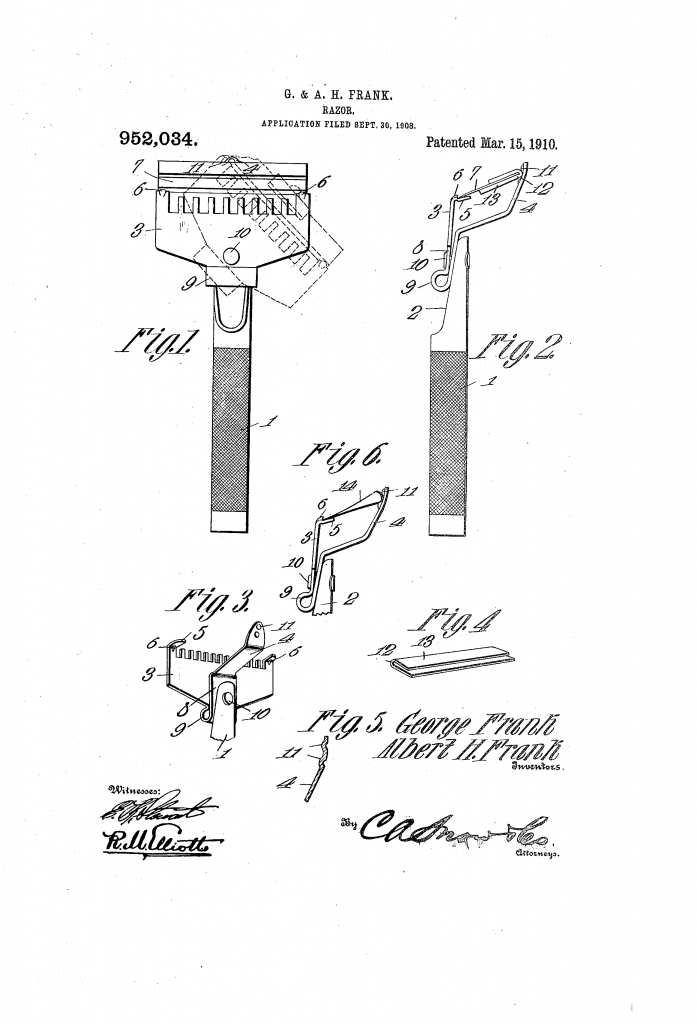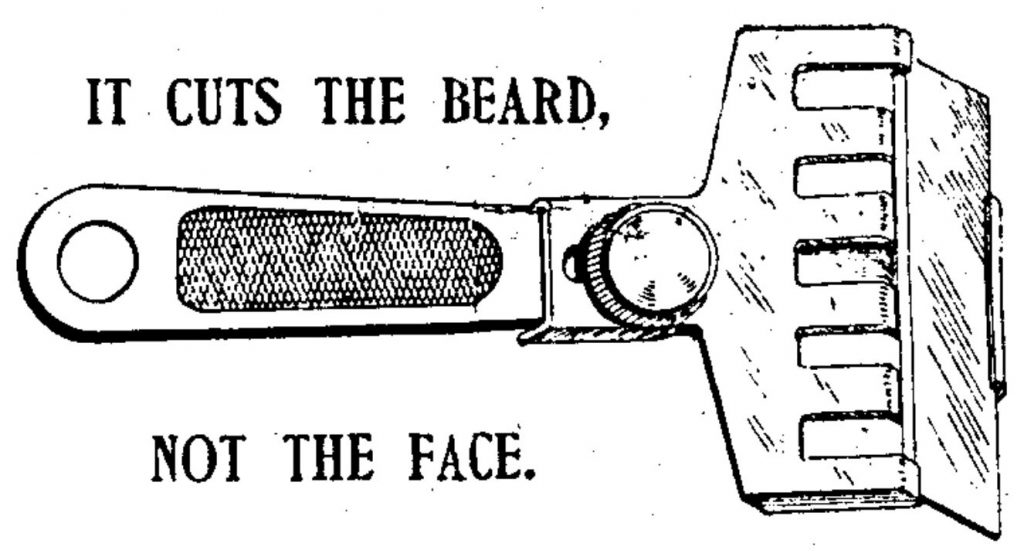The turn of the last century was an paradigm shift when it came to shaving technology. Wedge blades – which had been the cutting edge1 in the late 19th century – was replaced with the bleeding edge2 of easily manufactured and replaced thin steel blade. The Scimitar razor straddled the line, in that it could use both .
That means that while razors such as the Kampfe-Star had been at the forefront of technology when new, it was eclipsed by the EverReady and the Gillette with their thinner blades. I say thinner, but compared to todays blades they were still thick.
The Patent
It is natural to assume, looking back, that there was some disagreement as to which style blade was better. Wedge blades could last forever, but thin steel blades required a lot less maintenance. This may be part of the reason why the George and Albert H Frank3 invented the Scimitar razor – but it’s just as likely that the razors ability to use both came from the simple design.
Oh, and the head tilts. Much like the Otto Spahr’s razor did, and for much the same reason. But the tilting head isn’t what I find interesting.
Claiming – as these patents often do – that the invention is new and useful, the patent text goes on to state:
The object of the invention is to provide a razor of this character having a novel form of blade holder, the same being so constructed as. when pivotally connected with a handle, to operate as a brake or holding means for retaining the holder at any desired angle relatively to the longitudinal axis of the handle, whereby to permit of the razor edge being held at any desired angle to the face of the user. to effect either a draw or a shear cut, as may be preferred.
From US patent 952,034
Sounds simple enough. The handle of the razor is a length of metal tube, of any desired thickness and length. The edge is cut on a bevel, as shown in the drawing. Attached to this bevel is two stamped metal pieces, forming the guard and blade holder. This two piece head is held in place with a rivet or bolt.
The head and blade
The two pieces of the head should be made from “resilient material”. I read that to mean spring steel or springy brass – something that will provide a bit of clamping force when the blade is inserted. The guard – the bottom plate in todays nomenclature – had teeth and guard stops. The holder or clamp had stamped bumps to hold the read of the blade.
The preferred blade was a thin steel blade. For use it was to be fitted in a special holder – figure 4 on the drawing – that acted like the spine on a GEM-blade.4 The patent also points out that this arrangements allows the use of “ordinary” razor blade5 – in other words a wedge blade. In short, the Scimitar razor was set up use both existing blade technologies. This meant that the Frank-brothers didn’t have to worry about blade manufacture, but could piggyback of other razor manufacturers.

The company and manufacture
The Scimitar razor have an entry in Waits’ Compendium, although it’s not very long. It does however points out that the name is trademarked, and shows part of an advertisement. The razor in the advertisement differs markedly from the one depicted in the patent drawing.

For starters, the tilt adjustment seems to be gone. The handle looks to be flat, and the guard piece have two ears that prevent side-to-side motion. The flat, thin blade does not use a separate spine. And lastly the blade holder looks to be twice as wide as shown in the patent. It is possible that Waits is mistakenly showing a very similar, possible related razor, that was known as the Everybody’s.
I don’t know how long, in what quantity, or even if the Scimitar Razor was manufactured in the form that could take both flat and wedge blades. The internet, usually such an abundant source, is strangely quiet on the issue.
Final thoughts
Since the patent is long since expired, there is nothing stopping someone from recreating it today. It would be a fairly easy razor to manufacture, and can be set up to use standard GEM-blades with ease. However… how many modern shavers would go for a razor without a top cap? I know I would – double so if it was offered with wedge blades and a hone – but I suspect I’m in a minority on the issue. A newly manufactured version would need to change the name though, since there is at least one current production safety razor sold as the Scimitar.5
The full patent can be read at Google Patents, as the case usually is.
Footnotes:
- Sorry, bad pun.
- Ouch.. even worse pun. My apologies.
- Residing in Sandusky, Ohio.
- It is worth recalling that the very earliest EverReady and GEM blades were spineless.
- A bog-standard, straight forward brass and zinc three piece, sold by Bluebears Revenge in the United Kingdom.
